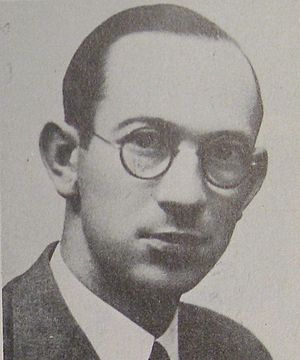José Castillo (police officer) facts for kids
Quick facts for kids
José Castillo
|
|
|---|---|

Castillo c. 1930.
|
|
| Born | 29 June 1901 |
| Died | 12 July 1936 (aged 35) |
| Police career | |
| Department | Regulares Guardia de Asalto |
| Allegiance | |
| Years of service | 1919–1936 |
| Rank | Lieutenant |
José del Castillo Sáez de Tejada (born June 29, 1901 – died July 12, 1936) was a Spanish police lieutenant. He served in the Guardia de Asalto (Assault Guard) during the Second Spanish Republic. His murder by members of a political group called the Falange on July 12, 1936, started a series of events. These events helped lead to the Spanish Civil War.
Contents
Early Life and Military Career
José Castillo was born in 1901. His father was a lawyer with liberal political ideas. His mother came from an important family. She was related to General Miguel Primo de Rivera, who was a leader in Spain from 1923 to 1930.
After finishing school in Granada, Castillo joined the Infantry Officers' Academy in Toledo in 1919. After he graduated, he became a junior officer. He served in the 1st Regulares, which were Moroccan colonial troops. He fought in the Rif War and became a Lieutenant. In 1925, he moved to a regular infantry regiment in Spain.
Serving the Republic
In 1931, the King of Spain was overthrown. A new government, the Second Spanish Republic, was formed. José Castillo was chosen to join the new Assault Guards. This was a special police force. Its job was to keep order in cities. It also balanced the power of the older, more traditional Guardia Civil. Officers for the Assault Guards were picked because they were loyal to the new Republic. Castillo himself had taken part in a protest in October 1934.
Castillo was a member of the Union Militar Republicana Antifascista (UMRA). This was an anti-fascist group for military members. He also helped train young people who supported socialism. In April 1936, he led an Assault Guard unit. They stopped riots that happened at the funeral of another police officer, Anastasio de los Reyes. Because of this, the Falange group targeted him. The Assault Guard generally supported the Republic. The Guardia Civil was more connected to the right-wing groups that would later start a rebellion.
His Assassination
Castillo was put on a list by the Falange. They wrongly blamed him for the death of Andrés Sáez de Heredia. Heredia was a cousin of José Antonio Primo de Rivera, a Falange leader. Heredia died during shooting at a funeral procession on April 14. This funeral was for Anastasio de los Reyes, the officer mentioned earlier.
Reyes had no known political views. However, left-wing groups in Spain blamed his death on fascists. Right-wing groups claimed him as their own. They held a large funeral as a protest against the government. Shots were fired at the funeral procession. Three people, including Heredia, were killed. Many more were hurt before Reyes was finally buried.
In June 1936, Castillo got married. His wife received a letter threatening his life. He had started training a socialist group after the Reyes funeral riots. On the evening of July 12, Castillo left his home in Madrid to start his night duty. Outside his home, four men with revolvers were waiting. They had been there for hours. They shot and killed him. The bullet holes can still be seen on the nearby wall. The gunmen escaped in the busy Sunday crowds and were never found. Castillo was the second military officer who supported socialism to be killed in five weeks.
What Happened Next
That same night, around 3:00 AM, Castillo's close friend, Police Captain Fernando Condés, acted in revenge. He and other police officers and leftist gunmen went to the home of José Calvo Sotelo. Sotelo was a leader of the monarchist party. He was also a rival of José Antonio Primo de Rivera, a leader of the far-right in Spain. They asked Sotelo to come with them for questioning.
While driving with Calvo Sotelo in a police van, a police officer and socialist gunman named Luis Cuenca shot him in the back of the neck. Sotelo's body was given to a funeral director without telling him who it was. Cuenca then went to the offices of a newspaper called El Socialista and told them what had happened.
Calvo Sotelo was a member of the Cortes (the Spanish parliament). This meant he had legal protection from arrest. It is hard to see why he was taken, other than to be killed.
Both Castillo and Calvo Sotelo were buried on July 14. Fighting broke out in the streets around the Madrid cemetery. This fighting was between the Assault Guard and fascist groups. Four people died. Three days later, on July 17, the army uprising began in Morocco. This uprising marked the start of the Spanish Civil War.
See also
 In Spanish: José del Castillo Sáenz de Tejada para niños
In Spanish: José del Castillo Sáenz de Tejada para niños

